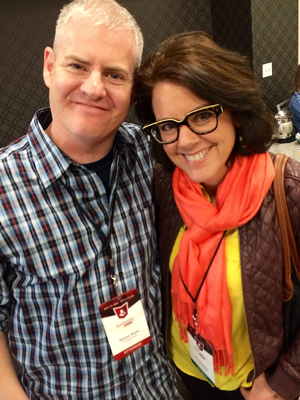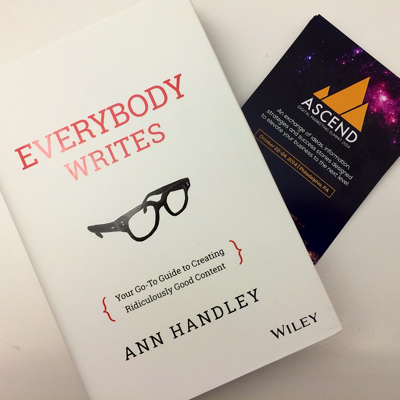Author Q&A: Ann Handley on Content, Creativity and Writing Consistently
By Hunter Boyle September 23, 2014
There are two types of content marketers: Those who already know how much Ann Handley rocks, and those who’ll find out soon enough.

Ann is one of my favorite writers, because her fun, personable, insightful style is also exactly what you get from her in real life, onstage and off. You’ll find that same persona on her blog, and throughout this interview about the book, her approach to content, and her advice to writers of every kind.
Hunter Boyle: You quote author Jeff Goins, who says habits “practiced once a week aren’t habits at all. They’re obligations.” What helps you bridge the gap between knowing you need to write daily, and making it happen?
Ann Handley: I suppose it’s like anything else: Make it a priority.
My life is crazy — like most of our lives. A year ago, I didn’t think I could possibly fit in time for workouts at the gym. As much as I wanted to do strength training, I signed up for a membership doubting I was actually going to be able to fulfill a three-times-weekly commitment.
But here we are a year later and now I can do 12 PUSH-UPS. (Insert stadium crowd cheer here!) Maybe that sounds lame, but for the spectacularly unathletic like me, it’s a tremendous achievement!
How did that happen? It’s because I made the gym a habit. The same mindset is required to become a better writer.
HB: You suggest that “there is no one way to write – just as there is no one way to parent a child or roast a turkey.” Meanwhile, many marketers are seeking “silver bullets” and guaranteed formulas for content. How can writers cultivate their own style and voice? And in 30 days or less? (Heh.)
AH: True, there is no one way to write, roast or parent… but there are terrible ways to do all three. What helps is to follow a kind of a content formula:
Useful x Inspired x Enjoyable = Innovative Content
The multiplication signs are key because if the value of one of those things is zero, then the sum of the equation is zero, too.
So, focus on being useful to your customers. Create content that inspires — either creatively, or by data, or both. And make it enjoyable for your customers, with pathological empathy for their point of view. Your own point of view and perspective (or voice) really does come out of focusing relentlessly on your customers.
HB: With content marketing, the importance of putting your audience needs first is undeniable. What are some of your favorite examples of brands doing this well? Ones that missed the mark? Any entrepreneurs or small businesses that have mastered the “pathological empathy” approach?
AH: There are so many favorites here, but in my mind the best brands focus on content that educates in an inspired way. They tell a bigger story than what they do or what they sell, and they focus on making the world a better place.
That sounds lofty but it’s really not. Here’s what I mean: Blue Apron wants to sell me ingredients to make dinners at home. But its content focuses on making me a better cook, and on educating me on food history and new ingredients, whether or not I choose to source from Blue Apron. The content is clear, beautiful and created to help me become a little smarter and more informed — not just to become a Blue Apron customer.
HB:The book outlines an excellent 12-step process, what you call the Writing GPS. Let’s dig into just a few aspects…
AH: Okay! Let’s do that.
HB: Step 5 “Write to one person” is similar to using personas and putting the reader first. How can new and emerging bloggers put this into practice? What have you learned from your own blog about this step?
AH: I think of the one person who I can help. That might be an invented person — but I try to think of an actual person. Side note: This is yet another good reason for marketers to get out and meet/talk to their customers.
HB: Step 6 “Produce The Ugly First Draft” advises us to write badly, and clean it up later. This is also the gap where many bloggers on a budget hit publish. What are some ways bloggers can get help on the editing side (also Step 10)?
AH: Few write well on a first draft. The Ugly First Draft (TUFD, for the acronymically inclined!*) suggests that you give yourself permission to write badly — put it all out there in its horrifically ugly glory. Then, go back and shape it into something presentable. (*I don’t think “acronymically inclined” is actually a thing.)
Those people who think they “can’t write” often give up before they begin. So the idea of TUFD can relieve some anxiety. As Stephen King says, “Write with the door closed. Edit with the door open.” Don’t worry about your audience until the rewrite, in other words.
Sources for external editing help include grammarly, Hemingway App, Autocrit, ProWritingAid and SmartEdit, to name a few. Keep in mind that none of these tools should be substitutes for human editors — or your own sensibility as a writer, for that matter. But they can provide excellent first passes before your text lands on the desk of an editor or copyeditor.
HB: Step 12 is all about the call to action, and writing that compels readers to take a specific step. Shed some light on your process for developing strong calls to action. And weaving that momentum throughout a piece, not just plugging it into buttons, footers and P.S. line copy.
AH: The best call to action is ridiculously great content that meets the needs of your customers. So as we’ve talked about, I focus first on meeting a customer’s needs. In the back of my brain is a little voice that says, “No one has to read this.” That sensibility makes me critical of my own work — of adopting a reader-centric point of view, or not being an indulgent writer. So I think of a CTA as an invitation to connect further, as in: “Like this? You might also like this.“
HB: You quote the inimitable Doug Kessler: “An hour with a fresh mind is worth five hours of fog.” Short of building a writing hideaway cabin in the woods, what are your tips for balancing the daily GSD regimen with forethought and fog-clearing? What tools or tricks do you use to minimize distractions?
AH: That Doug Kessler certainly is inimitable, isn’t he?
I suggest that you find the time of day when distractions are fewer and noise is muted. For me, that’s first thing in the morning. But the answer might be different for you: maybe it’s late at night after kids are in bed, maybe it’s grabbing time in a favorite corner of a coffee shop.
You’ve been living with yourself longer than I have, so I’ll leave that decision in your hands. 🙂
HB: The book includes a helpful list of 15 ways to organize and frame a blog post — e.g., quiz, case study, Q&A, outrageous. Are there any devices that you prefer or find most effective in general? Can you share a few examples?
AH: I like content that is more of an experience, that doesn’t just start and end, but that invites readers to get involved with your content. So one of my favorite examples is a social media quiz we produced at MarketingProfs: Poll: Choose Your Social Network.
The best part of that quiz was that we used the data to spawn more pieces of content on marketers and their favorite channels. We used a DIY tool called SnapApp (disclosure: I’m a SnapApp advisor), which allows marketers to take static pieces of content and create interactive spin-offs.
I also like Q&As, but that’s because I like hearing people’s personal stories. I like finding out the backstory, what makes them tick. I’m naturally curious, which is a nice way of saying I’m naturally nosy.
HB: Reaffirming a point from your previous book, Content Rules, you note that “the creators of the best content contemplate not just what story is worth telling but also how to tell it.” Where do you think the best stories come from? Who are some content creators (writers or brands) that inspire you?
The best stories are inspired by your customers: How does your product or service help them? How does it make their lives better? Ease their pain? I like how Crowd Mics tells its true story simple and directly, with real empathy for the pain of its customers.
I also think that great stories can be inspired by looking at other industries. As the designer Michael Wolff says, “What already exists is an inspiration.” So I love how Massachusetts Congressional candidate Carol Sciortino borrowed a page from storytelling, cleanly cracking open what a “political ad” “should” look like.
HB: In Chapter 63, you touch on writing humorously with social media. I suspect many writers would love to inject more humor into their content, but they feel too constrained or intimidated to do so. You make it seem effortless. What advice can you pass along here?
AH: Regarding humor, I like what Tiffany Beveridge says about looking for the “unexpected context” of a scene. What might you inject that would surprise your reader? What would seem hilariously implausible in a given situation?
Humor takes practice and some guts. And I also think you need to be a confident writer who trusts his or her own voice. So much of the style of writing really does come down to confidence.
HB: Let’s close this Q&A on a high note. You quote Neil Gaiman: “Start telling the stories that only you can tell, because there’ll always be better writers than you and there’ll always be smarter writers than you.” How can writers convert that idea into motivation? What are some of those unique stories you’d like to see?
AH: Wow. This is a big question!
What’s inherent in the Gaiman quote are two things: First, there’s a big a relief in knowing that being The Best isn’t a goal. Rather, just offer your unique perspective. And second, a “unique” story is ultimately about telling true stories with necessary style and a point of view.
I’d like to see businesses hire writers and editors who can help create stories with both style and substance. Airbnb excels at involving its community and artists to create marketing that doesn’t feel like marketing (to quote my friend Tom Fishburne).
Ultimately, of course, the best marketing doesn’t feel like marketing. Rather, it feels useful, and inspired, and empathetic to the needs, wants, and problems that your customers have.
Meet Ann In Person, Get Everybody Writes Free
No big orange call-to-action button here, but I recommend you grab a copy of Everybody Writes: Your Go-To Guide to Creating Ridiculously Good Content, dig into it, and apply the advice to your creative process. (It’s already on my top shelf alongside The Elements of Style, Stephen King’s On Writing, and Henry Miller’s On Writing.)
Or, you can register now for ASCEND Summit and get Everybody Writes for free, plus meet Ann and have your copy signed after her kick-off keynote. Find out more here…

Sean Brown
9/24/2014 10:12 amthanks for the insight I am going to order your book and I’m going to do exactly as it says
Hunter Boyle
9/24/2014 11:54 amThanks for the feedback, Sean. It’s an excellent book that I’d recommend to anyone and, well … everyone. Cheers!